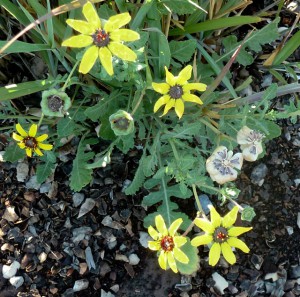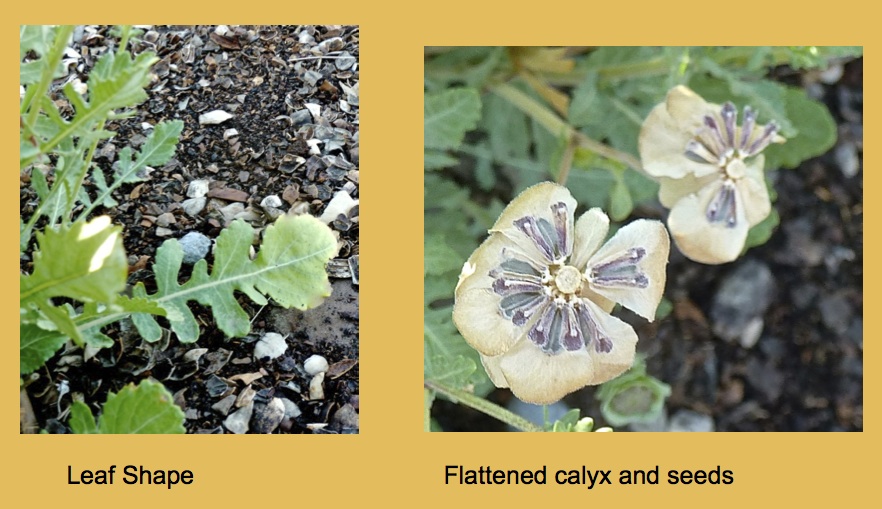Scientific name: Berlandiera lyrata
 Family: Aster (Asteraceae)
Family: Aster (Asteraceae)
Common names: Chocolate Flower, Green eyes
Article and photos by Janice Tucker
An early morning stroll through the garden is one of life’s little pleasures. The senses are filled with singing birds, colorful flowers, soft breezes picking up the tantalizing aroma of chocolate and…. Wait a minute! Chocolate? Absolutely. A garden blessed with the Berlandiera lyrata, also known as Chocolate flower, is heavily laden with the scent of cocoa, especially during the morning hours.
A perennial wildflower, the Chocolate flower is native to the Southwestern United States and Mexico and is often found in grasslands and growing along roadsides. Its hardiness, long blooming season and delectable fragrance have enticed many home gardeners to welcome the Chocolate flower into their landscaped flowerbeds.
 After frost the Chocolate flower seems to disappear, but its hardy roots ensure that it will emerge in the spring with a crown of scalloped segmented, wooly gray leaves. Fragrant flowers with yellow rays and maroon centers nestled upon a “calyx dish” are borne on long, hairy stems. The underside of the petals with its maroon stripes over the yellow background is even more colorful than the bright yellow petals that face outward.
After frost the Chocolate flower seems to disappear, but its hardy roots ensure that it will emerge in the spring with a crown of scalloped segmented, wooly gray leaves. Fragrant flowers with yellow rays and maroon centers nestled upon a “calyx dish” are borne on long, hairy stems. The underside of the petals with its maroon stripes over the yellow background is even more colorful than the bright yellow petals that face outward.
The Chocolate flower’s progression from flower to seed is intriguing, with each stage possessing its own particular beauty. As the temperatures rise, the yellow flowers will begin to turn white. The petals will close or drop off, leaving the center of the flower surrounded by a green, cup-shaped calyx. It is at this stage that the reason for the other common name, Green eyes, becomes apparent. The calyx will fade to a soft tan and flatten, allowing the light chocolate colored seeds to easily drop to the ground or to be dispersed by the wind or birds.

The Chocolate flower is hardy from zones 4 to 9 and grows in elevations as high as 7,000 feet. It will spread and naturalize as well as propagate by seed. It prefers full or partial sun in soil that has not been amended. The Chocolate flower will need very little water once it is established and will become leggy if it is overwatered or fertilized. The long blooming season from spring through frost is an added plus. Maximize the pleasure of the chocolate scent by planting clusters in borders near walkways. The Chocolate flower thrives in rock gardens and is a magnet for bees. It enjoys the company of Gaillardia, Perky Sue and Blackfoot daisies, all good companion plants with similar growing conditions.
The species lyrata means “lyre shaped”. The Berlandiera lyrata’s leaves are pinnately lobed (scalloped). Each scalloped segment roughly resembles a lyre, especially the tip end.
The genus Berlandiera is in honor of Jean-Louis Berlandier, a French-Swiss physician, naturalist and anthropologist. In 1820, he joined a scientific expedition to Mexico as a biologist and plant specialist. His botanical interests took him north, collecting and cataloging plants in parts of the Southwestern United States, including Texas and New Mexico. A man of many interests and talents, Dr. Berlandier became a practicing physician steeping himself in the Mexican culture and politics of that era. He never returned to his European homeland, remaining a resident of Mexico until his death in 1851.
Native Americans used the Chocolate flower to alleviate stomach problems. There are claims that the smoke from dried, burned roots will calm a nervous condition and in some cultures, inspire courage. The stamens have a flavor of unsweetened chocolate.
The Chocolate flower is as tough as it is desirable. When the hot, dry days of summer cause many garden beauties to hang their pretty heads, the Chocolate flower keeps up a continuous show of its bright yellow flowers with their dramatic maroon centers while suffusing the air with the rich scent of chocolate. Ah yes… that enticing scent of chocolate.



